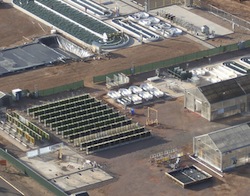SolarReserve has confirmed that the 110 megawatt (MW) Crescent Dunes Solar Energy Project located near Tonopah, Nevada, has entered the plant commissioning phase. According to the company, Crescent Dunes is the first utility-scale facility in the world to feature advanced molten salt power tower energy storage capabilities. The Crescent Dunes Project is more than five times the capacity output of pilot projects that have previously tested this technology.
Due to the result of the advanced energy storage technology, the 110 MW project will generate more than 500,000 megawatt-hours per year, enough to power 75,000 homes during peak electricity periods. This annual output, says the company, is more than twice that of other technologies per MW of capacity, such as photovoltaics (PV) or direct steam solar thermal. The storage technology also eliminates the need for any backup fossil fuels, such as natural gas, which are needed with other technologies to keep the system going during times of no or low solar resource. Nevada’s largest electric utility, NV Energy, will purchase 100 percent of the electricity generated, under a 25-year power purchase agreemen t. Full commercial operation is scheduled for later in 2014.
t. Full commercial operation is scheduled for later in 2014.
Commissioning is the initial stage of bringing the project into operations and includes system-by-system verification and startup, as well as equipment calibration and testing. Commissioning activities underway at Crescent Dunes include energization of the utility interconnection system and other electrical systems, as well as the first stages of testing and calibration of the heliostat field. This heliostat field is comprised of more than 10,000 “billboard-sized” mirrors that track the sun and total more than 1 million square meters of glass.
“Start of commissioning of the Crescent Dunes solar power plant marks a critical milestone for the project as well as the solar industry. We are now able to build utility-scale power plants, fueled only by the sun, which operate on-demand, day and night, just like traditional fossil fuel or nuclear power plants,” said SolarReserve’s CEO Kevin Smith. “SolarReserve’s industry-leading solar thermal energy storage technology solves the intermittency issue that limits the use of other renewable energy projects and thus enables firm, reliable delivery of electricity whether or not the sun is shining or the wind is blowing.”
SolarReserve’s energy storage technology at the Crescent Dunes plant is their techology showcase. They say it is a realistic solar energy solution that operates day and night like coal, natural gas, oil, diesel and nuclear plants, but without the harmful emissions or hazardous wastes associated those traditional plants. Additionally, Crescent Dunes includes the capability to dry cool the steam cycle, an environmentally friendly low water use feature that will saves millions of gallons of water each year. Once operational, the 110 MW Crescent Dunes plant will be the world’s largest solar thermal plant with fully integrated energy storage.
 Our latest ZimmPoll asked the question, “What’s best in the new farm bill?” More than a third of our respondents agree that crop insurance tops the charts, along with nothing. We see a bit of an oxymoron there!
Our latest ZimmPoll asked the question, “What’s best in the new farm bill?” More than a third of our respondents agree that crop insurance tops the charts, along with nothing. We see a bit of an oxymoron there! 








